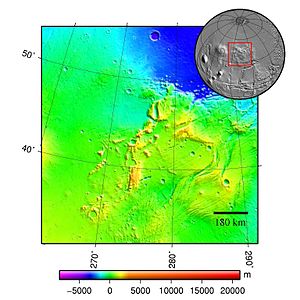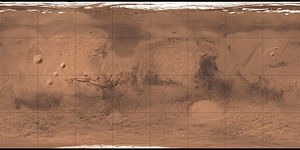Tempe Terra
Tempe Terra is a plateau on the planet Mars .
| Plateau on Mars | ||
|---|---|---|
| Tempe Terra | ||

|
||
| Topographic map of the Tempe Terra region | ||
|
|
||
| position | 54 ° 5 ' N , 50 ° 50' W | |
history
The Tempe Terra highlands were first described by the Greek astronomer Eugenios Antoniadis . During his observations of the area at the observatory in Paris , among other things, he was able to refute the widespread assumption that the "canals" observed by the astronomer Giovanni Schiaparelli were artificial waterways.
Areography
location
The highlands of around 2.1 million square kilometers are located in the northern hemisphere of the planet, with the center at 54.08 ° north latitude and 309.16 ° east longitude. The west is in the Arcadia , the east in the Mare-Acidalium - Gradfeld . In the north it borders on the Vastitas Borealis Plain surrounding the North Pole , in the east on the Acidalia and Chryse Plains, in the south on the Kasei Valles and in the south-west on the Tharsis region . The area is located between the southern highlands and the northern lowlands.
Surface structures

The area is characterized by a variety of tectonic structures and is considered to be one of the most geologically diverse on Mars.
Wrinkled back
The surface is characterized, among other things, by burr-like structures. These are so-called wrinkled ridges (lat. "Dorsa", English "wrinkle ridges"). Wrinkled ridges are forms of landscape that arise when the Martian crust is compressed by strong tectonic pressure and, due to the shortened surface, slight elevations eventually form.
Rifts
Furthermore, the region is criss-crossed by several rift valleys around one kilometer wide and several kilometers long. While wrinkled ridges develop due to the compression of the Martian surface, rift fractures are created by stretching the crust as a result of tectonic forces, so that the elongated surface forms cracks. Some rift breaks are partially covered by craters.
crater
In contrast to the flat, northern lowlands, the highlands have many impact craters . The younger craters partly cover older river and rift fracture systems, with which statements can be made about the chronological formation of the individual surface structures. The older impact craters have now been eroded by flowing water, covered by sediments or at least filled with sediments .
Valleys
The northeast, in which the highlands slowly descend to the lowlands by around one kilometer, is characterized by numerous valley systems.
Origin of name
The Tempe Terra was named after a valley in the Greek Thessaly , in which, according to Greek mythology, after Eurydice , the wife of Orpheus , died from a snakebite while fleeing from her tormentor Aristaios .
Web links
Individual evidence
- ↑ a b c d "Wrinkled Ridge" and rift valleys in Tempe Terra. German Aerospace Center, January 6, 2012, accessed on March 29, 2020 (German).
- ↑ Planetary Names: Terra, terrae: Tempe Terra on Mars. Retrieved March 29, 2020 .
- ↑ a b Tempe Terra Orbit 9622. Free University of Berlin, Faculty of Planetary Sciences and Distance Studies, January 6, 2012, accessed on March 29, 2020 (German).

